
When selecting trees for your landscape, you will make some very important choices in regards to your outdoor environment and the exterior of your home. Whether you’re starting from scratch with a blank canvas to create the garden of your dreams or making changes to an already existing space, the trees you choose and how they grow will affect all other gardening you intend to do. The same choices will influence how efficiently your home is heated and cooled based on where the trees cast shade or allow the sun to shine through. Tree choice and location will also help determine where permanent features of the landscape, such as driveways, parking areas, patios, decks, and swimming pools, might be located in relation to how the shade of a tree’s canopy or the encroachment of its roots might have certain advantages or consequences.
Unfortunately, tree selection is often based solely on how a tree looks—its ornamental value. This is how, in the 1980s, we ended up with subdivisions full of Bradford pears, based on looks alone. Thirty years later, these trees have reached the end of their useful lives and are found splitting in half, landing on cars and houses with little or no warning, and homeowners are literally paying the price.
Trees, for the most part, are as permanent as any building or structure on your property and should be chosen with that in mind. In addition to their practical applications and the beauty they provide, trees, as they grow and mature, add to the monetary value of your property. In the following pages, you’ll find recommendations for the replacement of problem trees, as well as new and unusual forms of some of the most desirable ornamental and shade trees.
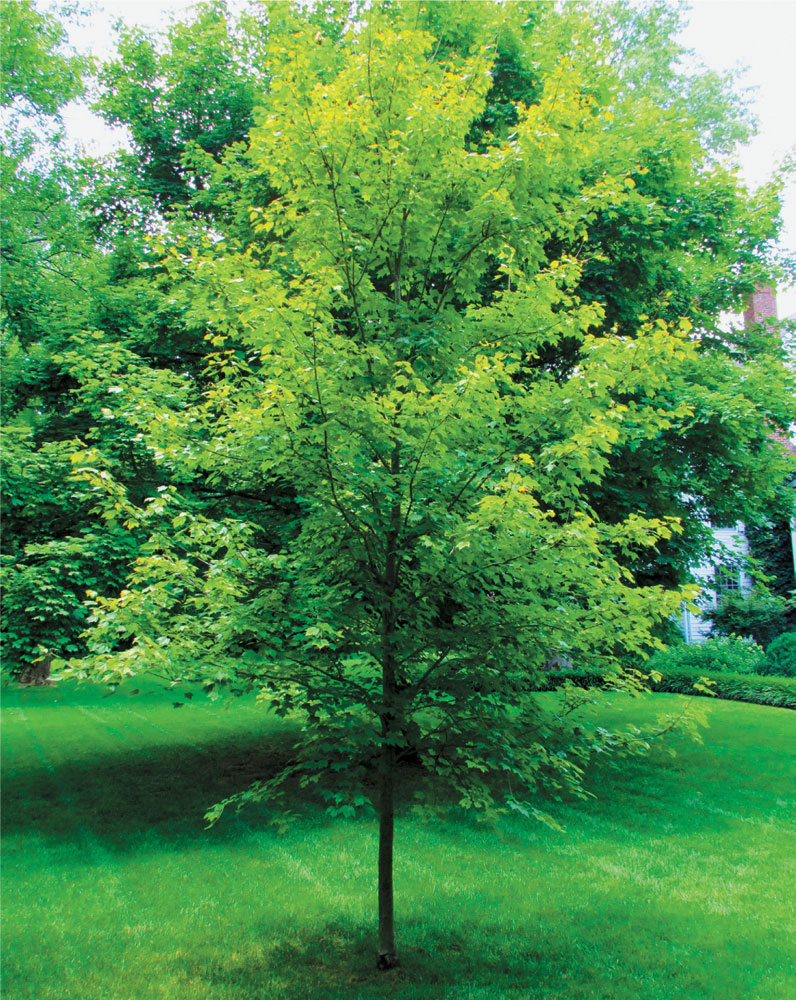
 ‘Autumn Blaze’ maple can be used in the same way as callery pear in the landscape, as specimen trees, property boundaries, and as an attractive tree for lining a drive.
‘Autumn Blaze’ maple can be used in the same way as callery pear in the landscape, as specimen trees, property boundaries, and as an attractive tree for lining a drive.  FULL SUN.
FULL SUN.  ZONES 3 TO 9.
ZONES 3 TO 9.
For fast growth, durability, and spectacular fall color, few trees can rival the newer selections of red maple like ‘Autumn Blaze’. A hybrid between two native species, it combines the beauty and durability of the red maple with the fast growth rate of the silver maple, making for a marriage made in horticultural heaven. Because of its native parentage, there is little cause for concern about the tree seeding into the natural environment, should the occasional seedling appear. Other varieties of red maple that are worthy of consideration include ‘Armstrong’, ‘Autumn Flame’, ‘October Glory’, and ‘Red Sunset’. All were selected for their outstanding and long-lasting displays of red fall color.
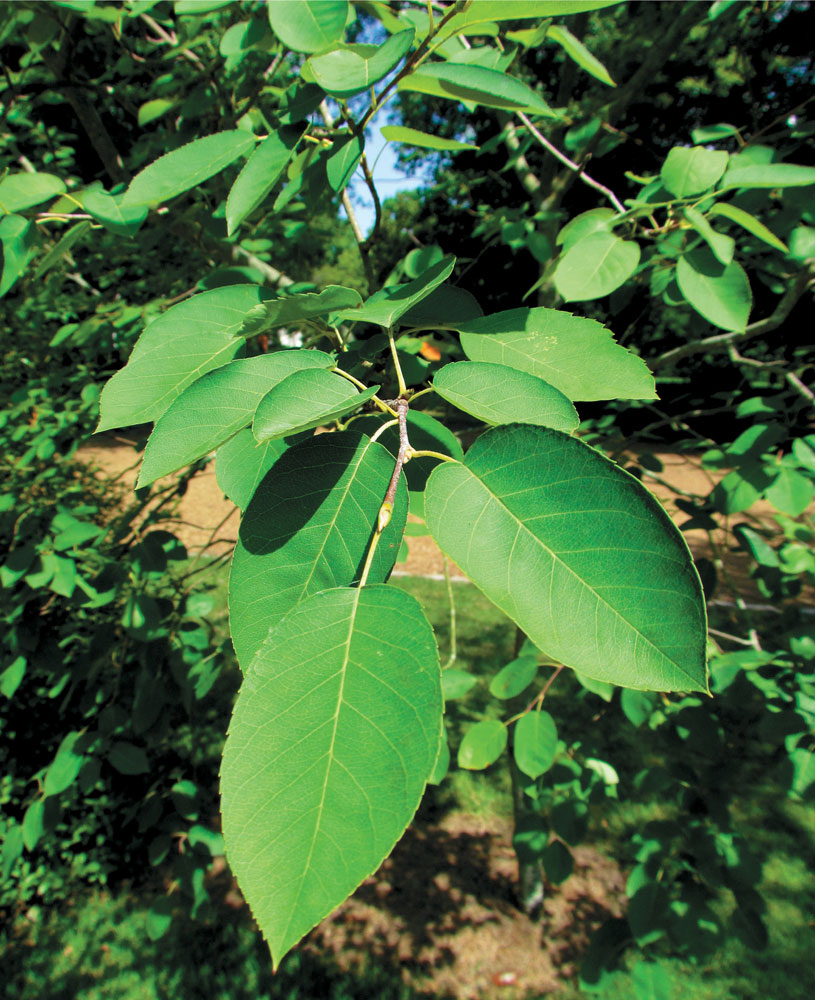
 Serviceberry is a smaller growing tree, but highly ornamental and useful as a smaller focal point or understory planting. Berries are beloved by wildlife and attract a tremendous range of birds to the garden as they ripen.
Serviceberry is a smaller growing tree, but highly ornamental and useful as a smaller focal point or understory planting. Berries are beloved by wildlife and attract a tremendous range of birds to the garden as they ripen.  FULL SUN TO PART SUN.
FULL SUN TO PART SUN.  ZONES 4 TO 8.
ZONES 4 TO 8.
If it’s the white flowers of the callery pear’s spring show you love, why not plant native serviceberry or one of its hybrid offspring? ‘Autumn Brilliance’ (Amelanchier x grandiflora) provides white spring blooms followed by red berries beloved by wildlife and the same deep, ruby red color in late autumn that so many associate with the flowering pears that now dominate our gardens. Growing the trees in the open landscape rather than as understory trees allows them to fully develop and reach their greatest potential. When grown in the shade of taller trees, they always seem a little weak and bent, but when they are planted in the sun and free to grow unencumbered by surrounding trees, they can be beautiful!
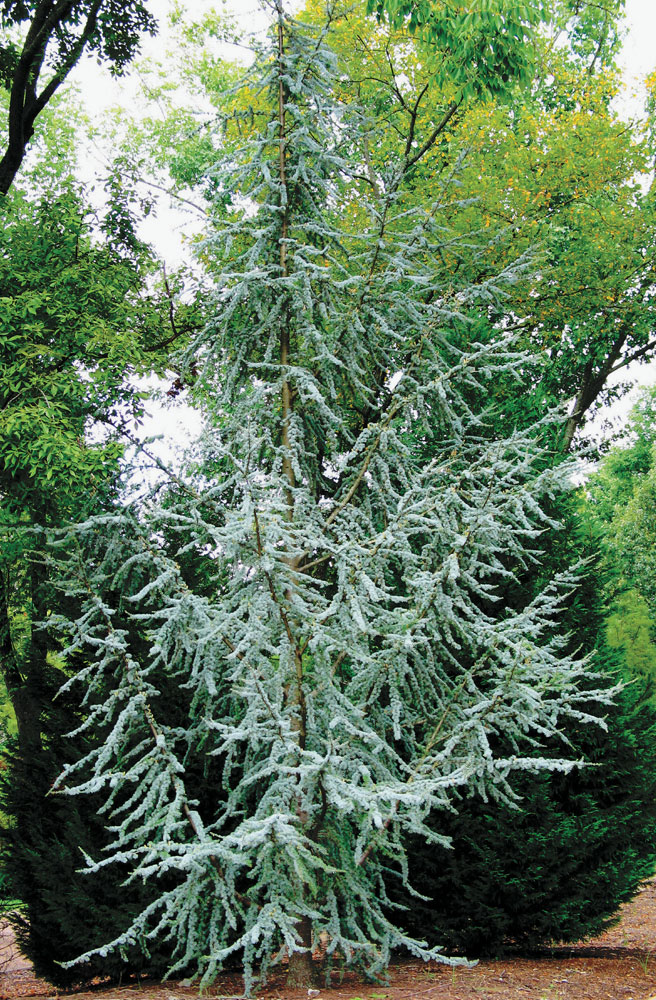
 In warm climates, atlas or deodar cedar are two of the best alternatives to Colorado blue spruce. Young trees may grow 2 to 3 feet per year, forming impressive specimens in under ten years.
In warm climates, atlas or deodar cedar are two of the best alternatives to Colorado blue spruce. Young trees may grow 2 to 3 feet per year, forming impressive specimens in under ten years.  FULL SUN.
FULL SUN.  Atlas cedar is the hardier of the two, to ZONE 6. Deodar cedar is hardy to ZONE 7.
Atlas cedar is the hardier of the two, to ZONE 6. Deodar cedar is hardy to ZONE 7.
In warmer climates, where Colorado blue spruce suffers from heat, humidity, and a variety of other problems, blue atlas cedar (Cedrus atlantica ‘Glauca’) is just what the doctor ordered for adding that silvery blue color to the landscape. With evergreen needles similar in size, shape, and color to the best blue forms of the Colorado spruce, it is the answer to gardeners’ prayers in Zone 7 and warmer, where the spruces suffer. Young plants may be open and rangy in appearance when first planted, but once established will quickly fill in to form upright, pyramidal specimens that with time will become some of the most magnificent trees in the landscape.
Similar in overall appearance to the blue atlas cedar, but with a fuller habit and golden yellow new growth in spring and early summer, is the golden deodar cedar (Cedrus deodara ‘Aurea’). Faster growing than one might expect in its youth, it quickly forms an impressive specimen that only becomes more imposing and remarkable with age. While it doesn’t offer the year-round blue color of the others, its deep green needles tipped in golden yellow lend a soft glow to the landscape throughout the year. Silvery green forms do exist, ‘Kashmir’ and ‘Shalimar’ being two of the best, but neither matches the blue coloration of the best spruces.

 A fast-growing and sturdy tree, also growing quite large with age. It is best suited to larger yards and landscapes. Fall color can be spectacular, in an unusual shade of russet orange. Once thought to be extinct, it was rediscovered in China in 1944.
A fast-growing and sturdy tree, also growing quite large with age. It is best suited to larger yards and landscapes. Fall color can be spectacular, in an unusual shade of russet orange. Once thought to be extinct, it was rediscovered in China in 1944.  FULL SUN.
FULL SUN.  ZONES 4 TO 8.
ZONES 4 TO 8.
Another fast-growing, but sturdy and long-lived tree, the dawn redwood, Metasequoia glyptostroboides, is one of the finest choices for today’s landscapes. In warmer climates with longer growing seasons, it may grow as much as 5 to 6 feet per year in its youth, slowing down and becoming more structural and stately as it ages. Its soft, feathery leaves remind one of a hemlock or other evergreen, but in late fall those leaves turn a spectacular shade of russet-orange, persist for several days, and then fall to the ground. Again, a larger tree is probably not suited for the smallest subdivision lots, but where you have the space to grow a true specimen tree, few are more beautiful.

 Fast-growing and becoming very large over time, tulip poplar is best suited to larger yards and landscapes. Around age ten it will begin producing its beautiful goblet-shaped blooms reminiscent of tulips.
Fast-growing and becoming very large over time, tulip poplar is best suited to larger yards and landscapes. Around age ten it will begin producing its beautiful goblet-shaped blooms reminiscent of tulips.  Deep rooted and providing high, dappled shade, it allows other plants to grow easily underneath it.
Deep rooted and providing high, dappled shade, it allows other plants to grow easily underneath it.  FULL SUN.
FULL SUN.  ZONES 4 TO 9.
ZONES 4 TO 9.
Some may argue that tulip poplar, Liriodendron tulipifera, is simply an even trade with the eastern cottonwood—that perhaps it doesn’t have any more redeeming qualities about it than the tree it’s intended to replace. I disagree. For a fast-growing tree, the tulip poplar is actually quite durable, and where you need a good tree, fast, tulip poplar fills the bill. Growing 3 feet or more a year, a 10-year-old specimen can easily reach 30 to 35 feet with a 20- to 25-foot spread. That’s a good bit of shade in a pretty short amount of time, all things considered. Its growth rate coupled with its very attractive habit, its uniquely shaped leaves, and, when it’s old enough, its green and pale orange tulip-shaped flowers (hence, the name) makes a more than satisfying landscape tree. It does grow large, so is probably not well suited to the smallest properties.
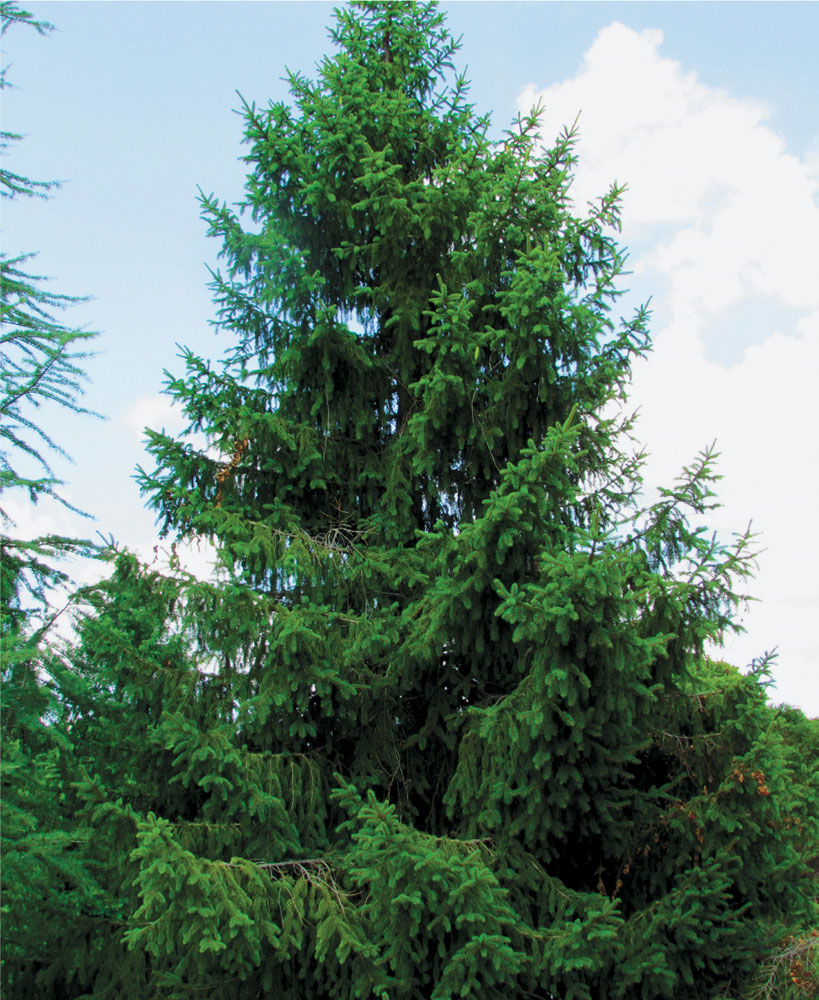
 Norway spruce is hardy and adaptable to a wide range of conditions. Norway spruce is more tolerant of cold winter winds and a better choice for windbreaks or planting in open areas. It will become broad spreading at the base as it matures.
Norway spruce is hardy and adaptable to a wide range of conditions. Norway spruce is more tolerant of cold winter winds and a better choice for windbreaks or planting in open areas. It will become broad spreading at the base as it matures.  FULL SUN.
FULL SUN.  ZONES 2 TO 7.
ZONES 2 TO 7.
It may seem unusual to recommend a spruce in place of a pine, but the Norway spruce (Picea abies) because of its deep green color, similar habit of growth, and adaptability from North to South makes it a more than acceptable substitute. As a young plant, it is relatively fast growing, upright, and pyramidal. With age, the base broadens out to impressive proportions. The weight of the limbs causes the tree to take on a graceful, semiweeping form that is stately and elegant in the landscape, giving a great sense of age and maturity. Hardy from Zones 2 to 7, it is as adaptable as nearly any other conifer, requiring only full sun and rich, well-drained soil—no spruce likes wet feet!

 Japanese cedar is hardy and adaptable to a wide range of conditions. It benefits from some moisture at its roots. It may need protection from harsh winter winds to avoid drying and wind burn. ‘Yoshino’ Japanese cedar remains upright as it ages.
Japanese cedar is hardy and adaptable to a wide range of conditions. It benefits from some moisture at its roots. It may need protection from harsh winter winds to avoid drying and wind burn. ‘Yoshino’ Japanese cedar remains upright as it ages.  FULL SUN TO PART SUN.
FULL SUN TO PART SUN.  ZONES 5 TO 9.
ZONES 5 TO 9.
Since pines are largely out of the question as replacements for other pines, we must turn to other types of evergreens for substitutes. Japanese cedar (Cryptomeria japonica) is one such plant. The cultivar ‘Yoshino’ is a handsome form that is being made more widely available to homeowners by enterprising nursery owners and retail centers, which have seen the need for alternative forms of evergreens for the landscape. Its bright green needles turn an attractive shade of bronze in winter and its fast rate of growth makes it excellent for screening. It maintains its graceful, pyramidal shape for many years, much like the white pine does in its youth. One of the most adaptable conifers, it will grow from Zone 5 (as far north as Boston) well into the subtropical regions of Zone 9.
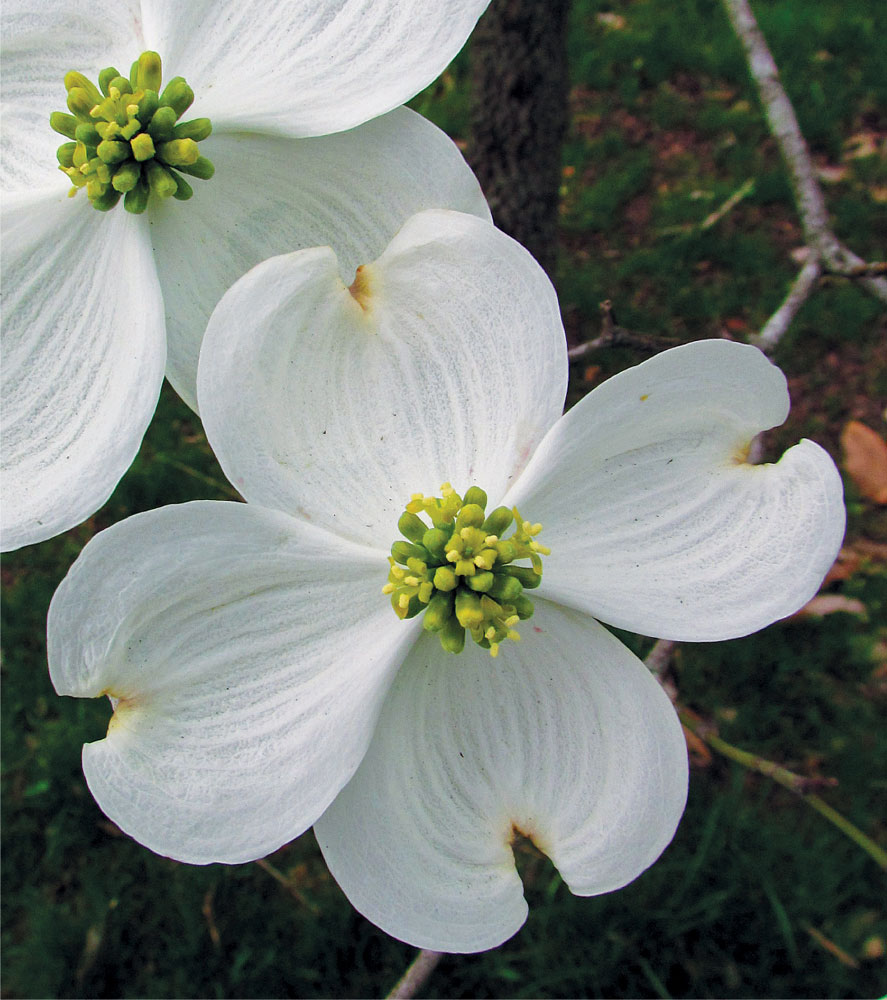
 Rutgers University’s hybrid dogwoods are resistant to both anthracnose and powdery mildew. Chinese or Kousa dogwood is also highly disease resistant. It requires full sun, even in the South, for peak growth and flowering.
Rutgers University’s hybrid dogwoods are resistant to both anthracnose and powdery mildew. Chinese or Kousa dogwood is also highly disease resistant. It requires full sun, even in the South, for peak growth and flowering.  Cornus florida: FULL TO PART SUN. ZONES 5 TO 8.
Cornus florida: FULL TO PART SUN. ZONES 5 TO 8.  Cornus kousa and its hybrids: FULL SUN. ZONES 4 TO 8.
Cornus kousa and its hybrids: FULL SUN. ZONES 4 TO 8.
Disease-resistant selections of the native dogwood have been made in recent years with the cultivar ‘Appalachian Spring’, discovered in Catoctin Mountain Park, Maryland, and tested extensively for resistance to anthracnose at the University of Tennessee prior to its release in 1998, leading the way. It has also been used in several breeding programs to introduce disease resistance into native dogwood species in the hopes that future introductions will be resistant or possibly even immune to the anthracnose disease.

Essentially immune to dogwood anthracnose, the Chinese dogwood (Cornus kousa) has been used extensively in the disease-resistant hybrids, but it is an excellent garden addition in its own right. Flowering about one month after native flowering dogwood, it extends the flowering season into mid- and late spring, bearing its creamy white blooms on the topside of branches that grow nearly parallel to the ground on mature specimens, creating a spectacular show. Large, fleshy, bright red fruits that resemble raspberries follow the flowers, extending the tree’s show well into late summer and autumn.
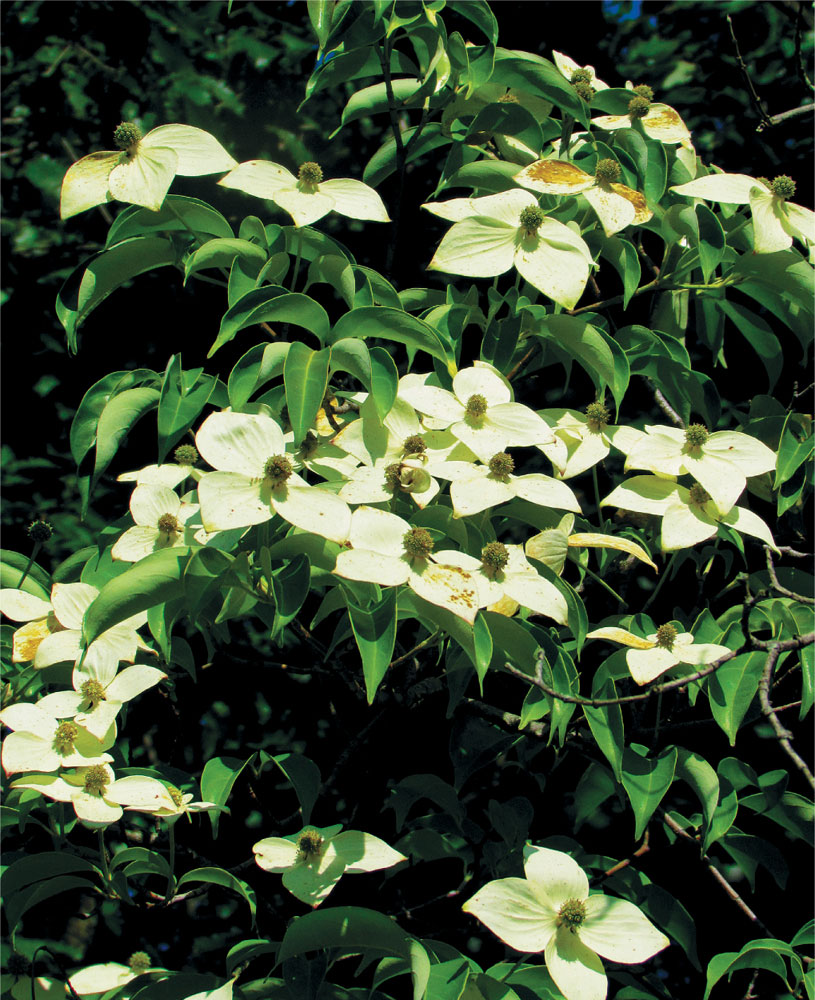
In the early 1990s the first cultivars in the Stellar Series® of dogwoods from the breeding program of Dr. Elwin Orton of Rutgers University were released to nursery trade and eventually made their way into nurseries and garden centers. This breakthrough in breeding involved creating hybrids between native flowering dogwood and the Chinese or Kousa dogwood, which is highly resistant to both anthracnose and powdery mildew. Selections such as Stellar Pink®, Constellation®, Celestial®, and Ruth Ellen® are now widely available and make hardy and disease-resistant additions to any landscape.
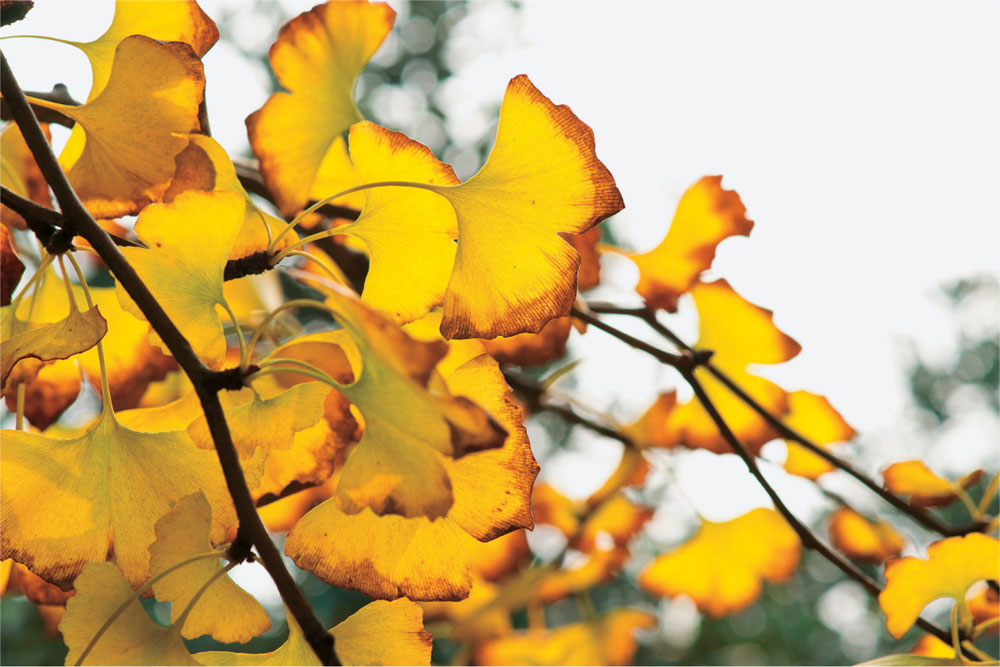
 Male selections do not bear fruit. A wide variety of sizes and forms are available, making the ginkgo suitable for nearly every landscape, large or small. Dwarf forms are outstanding garden accents and can be made into beautiful, bonsai-like specimens.
Male selections do not bear fruit. A wide variety of sizes and forms are available, making the ginkgo suitable for nearly every landscape, large or small. Dwarf forms are outstanding garden accents and can be made into beautiful, bonsai-like specimens.  FULL SUN.
FULL SUN.  ZONES 3 TO 8.
ZONES 3 TO 8.
There are a number of male ginkgos on the market today, all of which are fruitless, since only the female trees bear fruit. These are propagated by cuttings or grafts, so they are guaranteed to be true to type, whereas trees grown from seed cannot be determined to be male or female until they begin flowering or fruiting, and by then, it’s too late. ‘Autumn Gold’ is a fine male variety that is virtually pest free, tolerant of a wide range of soil types, and quite drought tolerant, once established. Its consistent and dramatic golden yellow fall color is one of its most desirable traits, lighting up the autumn landscape as it prepares to drop its leaves for winter.
In addition to the standard ginkgo, whose uniquely shaped green leaves are interesting enough on their own, there are several varieties that have been selected for even more ornamental character, including dwarf forms that make beautiful accents for small gardens and variegated types whose leaves are striped in shades of cream and gold. ‘Majestic Butterflies’ was selected for its highly variegated green-and-yellow-striped leaves. In autumn, the green sections of the leaves turn yellow, while the yellow stripes turn white, creating an even more dramatic effect when viewed up close. Dwarf forms, such as ‘Gnome’ and ‘Chase Manhattan’, thrill collectors and add unique and unusual interest to even the smallest gardens or courtyards, while threadleaf or tube-leafed forms such as ‘Tubiformis’ add exciting and highly unusual textural interest to the landscape.
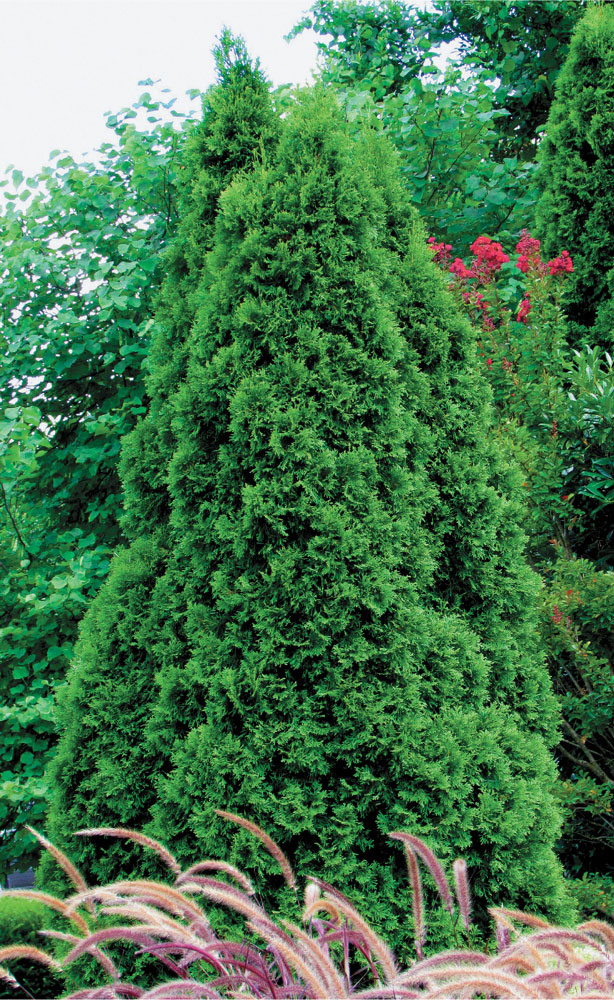
 Arborvitae comes in a wide variety of habits and colors. Larger-growing varieties resemble Leyland cypress. ‘Green Giant’ is the fastest growing and most similar in size to Leyland cypress. Arborvitae is not susceptible to the root problems of Leyland cypress.
Arborvitae comes in a wide variety of habits and colors. Larger-growing varieties resemble Leyland cypress. ‘Green Giant’ is the fastest growing and most similar in size to Leyland cypress. Arborvitae is not susceptible to the root problems of Leyland cypress.  FULL SUN.
FULL SUN.  ZONES 3 TO 8, depending on variety.
ZONES 3 TO 8, depending on variety.
Many homeowners plant Leyland cypress not understanding their ultimate size, which is much larger than anyone might expect. Often, they are seen covering the front of a home, blocking a door or passageway, or completely engulfing an outbuilding because they were planted too close to an existing structure when they were small. ‘Emerald’ arborvitae is a terrific choice where evergreen accents or screening are desired, but space is limited. Its narrow, conical form makes it great for tight spaces, and its ultimate size of just 15 feet high by 4 to 5 feet wide makes it a better fit for most landscapes.
While they are perhaps not suited to long hedges or windbreaks, there are some colorful golden or variegated forms of arborvitae that make outstanding focal points in the landscape, and new dwarf types, with a variety of foliage colors and forms, are wonderful accent plants for the garden.
‘Green Giant’ arborvitae is an exceptional alternative to the Leyland cypress, where evergreen screening and a fast rate of growth are desired. It is not uncommon to see 3 to 5 feet of growth per year from established plants, given full sun, well-prepared soil, and regular watering during the growing season. Rarely susceptible to the root rot diseases that plague Leyland cypress, it is a much more suitable choice for the landscape. Unlike many arborvitae that are known for turning an undesirable bronzy brown during the winter months, ‘Green Giant’ maintains its deep green foliage color throughout the year. It should be noted that like Leyland cypress, ‘Green Giant’ does grow large, reaching 45 to 50 feet tall with a 20-foot spread at maturity. Place them wisely with that in mind.

 Red maple grows well in damp or wet areas and is tolerant of clay soils. Red maple is medium-sized and useful as a shade tree on smaller lots. Sugar maple is large and broad-spreading, best suited to larger landscapes.
Red maple grows well in damp or wet areas and is tolerant of clay soils. Red maple is medium-sized and useful as a shade tree on smaller lots. Sugar maple is large and broad-spreading, best suited to larger landscapes.  FULL SUN for best fall color.
FULL SUN for best fall color.  ZONES 4 TO 8.
ZONES 4 TO 8.
One of the finest alternatives to the Norway maple is the native red maple (Acer rubrum) or better yet, one of its outstanding cultivars such as ‘October Glory’ or ‘Red Sunset’. Since both are selections of native species, reseeding into surrounding woodlands or wild areas is of little concern. ‘Red Sunset’ is slightly better suited to gardens north of Zone 7, while ‘October Glory’ will perform well into Zone 8, where it colors up reliably in the autumn even without the benefit of very cold temperatures. Both are relatively fast-growing, free from pests, and make durable and beautiful landscape trees.
A similar tree that is especially well suited to northern gardens is the ‘Autumn Blaze’ maple (Acer x freemanii), a hybrid between the red maple and a tree that is often thought of as undesirable, the silver maple. It combines the best attributes of both parents: the tidy, oval outline and exceptional fall color of the red maple with the attractive, deeply lobed leaves and fast growth rate of the silver maple.
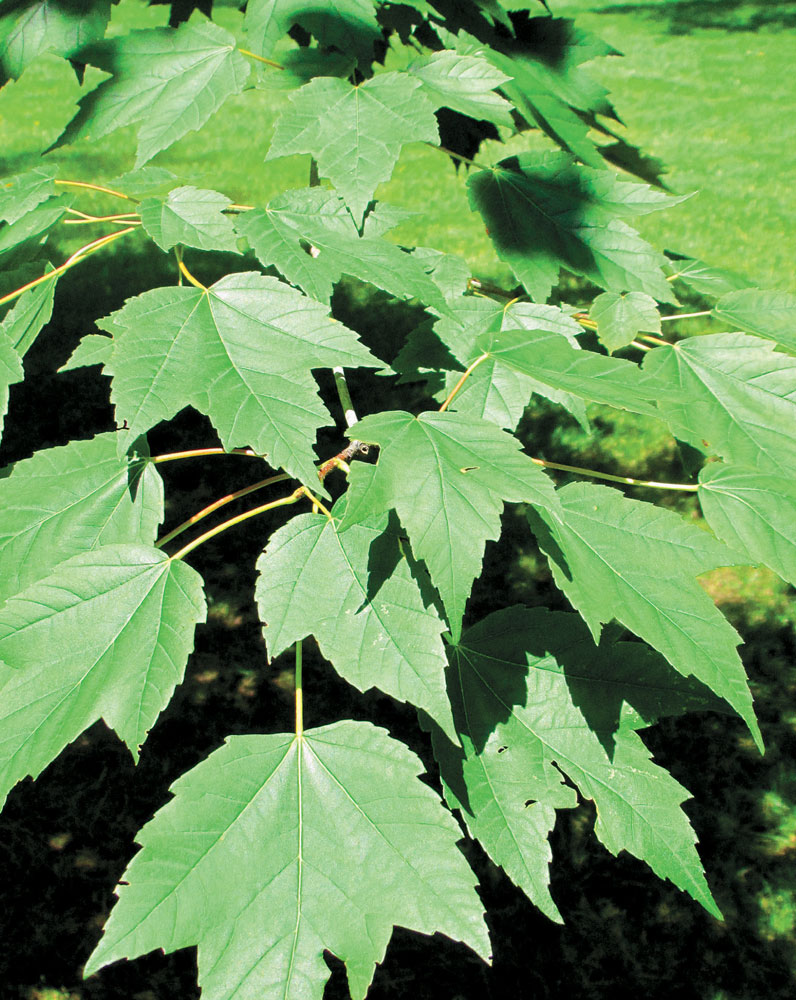
Another outstanding choice for the landscape, the native sugar maple is the tree that lights up hardwood forests east of the Mississippi in autumn with its stunning display of brilliant, golden orange color. ‘Green Mountain’ has leathery, dark green leaves that are resistant to heat scorch and golden yellow to orange-red fall color that can be spectacular. It grows well in the North, but it is also tolerant of the heat and humidity of the South.

 New selections of redbud provide long seasons of landscape interest with beautifully colored foliage, as well as flowers. Weeping forms make excellent ornamental focal points for smaller landscapes. Improved forms maintain leaf color throughout hot, humid summers without fading or scorching.
New selections of redbud provide long seasons of landscape interest with beautifully colored foliage, as well as flowers. Weeping forms make excellent ornamental focal points for smaller landscapes. Improved forms maintain leaf color throughout hot, humid summers without fading or scorching.  FULL TO PART SUN.
FULL TO PART SUN.  ZONES 4 TO 9.
ZONES 4 TO 9.
If it’s a lighter and brighter spot you need in the landscape, try the new Floating Clouds™ redbud. It’s highly variegated green and white leaves will not scorch, even in full sun, and its light pink flowers in early spring are a welcome sign that winter’s grip is loosening.
While all of the forms mentioned here are of the standard, upright growth habit, many weeping forms are also being introduced. Excellent as ornamental specimens and focal points for small gardens, varieties such as ‘Ruby Falls’, ‘Whitewater’, and ‘Traveller’ should not be overlooked.
If you find the dark-leafed ‘Forest Pansy’ redbud attractive, then you will love Merlot™. When ‘Forest Pansy’ begins to fade in midsummer, its leaves turning an unattractive shade of bronze, Merlot™ holds its glossy, near-black leaves with little fading or discoloration, lending its deep, dark color to the landscape throughout the summer and well into autumn. Like ‘Forest Pansy’, its spring blooms are a sumptuous shade of deep, purplish pink.
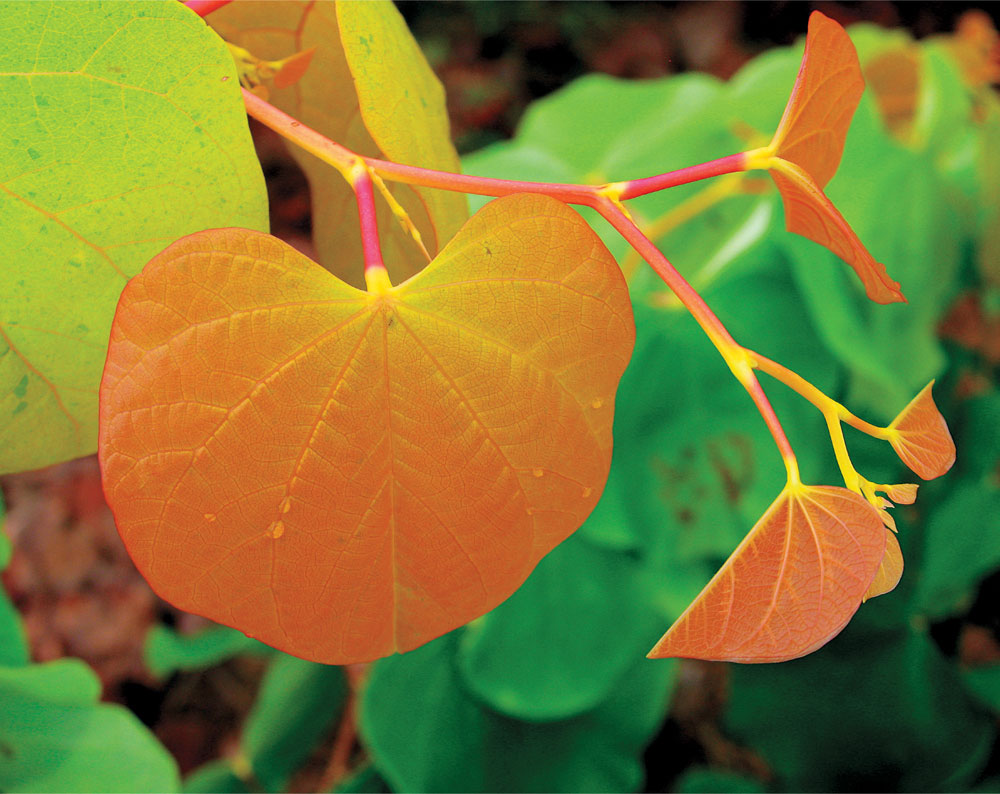
The newest redbud introductions have spectacular foliage color in addition to their beautiful spring blooms, which give the trees many months of beauty and interest in the landscape. One of the most dazzling is The Rising Sun™ redbud, introduced by Ray and Cindy Jackson of Jackson Nursery in Belvidere, Tennessee. With bright, golden yellow leaves and orange new growth, it continues its colorful show long after its early spring flowers have faded. Where many golden or variegated plants may scorch in summer’s heat and humidity, the leaf color of The Rising Sun™ actually intensifies as the summer goes on, continuing right up to leaf drop in late autumn.
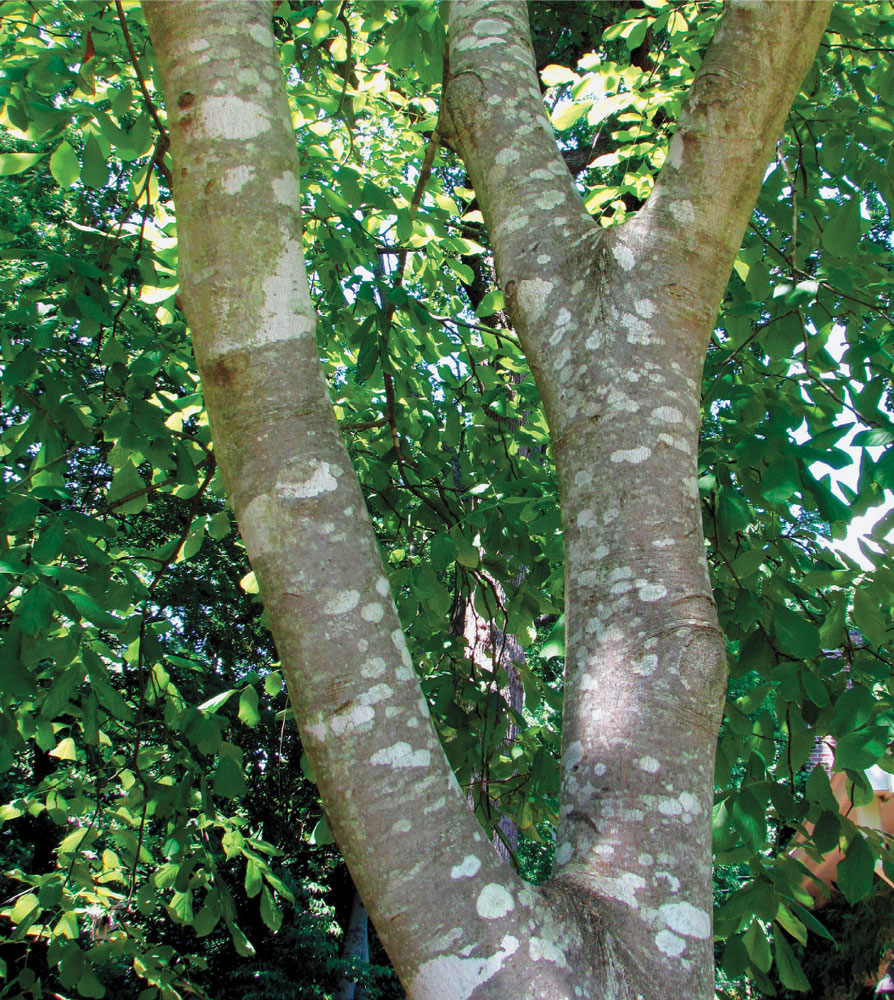
 American yellowwood has showy, fragrant white flowers and is especially beneficial to honeybees. It is well suited to today’s smaller landscapes, being of medium size and having a noninvasive root system. Yellowwood’s smooth, silvery gray bark is especially attractive in the winter landscape.
American yellowwood has showy, fragrant white flowers and is especially beneficial to honeybees. It is well suited to today’s smaller landscapes, being of medium size and having a noninvasive root system. Yellowwood’s smooth, silvery gray bark is especially attractive in the winter landscape.  FULL SUN.
FULL SUN.  ZONES 4 TO 8.
ZONES 4 TO 8.
The American yellowwood (Cladrastis kentukea) is a fine, medium-sized native tree with many positive attributes. It has excellent flowers, foliage, and bark; maintains a good rate of growth; and can be used either as a shade tree on smaller, urban lots or as a medium-sized ornamental on larger properties. Clusters of fragrant white flowers hang from the tree in mid-spring, and fall color is often a clear and lustrous yellow. Smooth bark mottled in shades of silvery gray adds winter interest to the landscape. Ultimately reaching 30 to 40 feet tall with a similar spread, it will not overwhelm the landscape, and its deep, noninvasive roots are less likely to invade foundations or cause problems for lawns or landscaping.

 Black gum may be intolerant of high pH soils, preferring acidic conditions and excellent drainage. Exceptional red fall color makes sourwood a favorite native ornamental tree. Sourwood is well suited to today’s smaller landscapes, being of medium size and having a noninvasive root system.
Black gum may be intolerant of high pH soils, preferring acidic conditions and excellent drainage. Exceptional red fall color makes sourwood a favorite native ornamental tree. Sourwood is well suited to today’s smaller landscapes, being of medium size and having a noninvasive root system.  FULL SUN.
FULL SUN.  ZONES 5 TO 9.
ZONES 5 TO 9.
Another outstanding alternative to the river birch is the native black gum (Nyssa sylvatica). Of more modest size, it grows 35 to 45 feet tall with a similar spread, making it well suited to the landscape as a specimen tree or moderately sized shade tree. Its spectacular and consistent fall color is lustrous, deep red. Black gum has a tremendous range of hardiness, from Zones 3 to 9, making it one of the most adaptable native trees where climate is concerned. However, it is somewhat particular about pH, preferring neutral to acidic soil, and is not particularly well suited to regions where limestone bases create alkaline soil conditions.
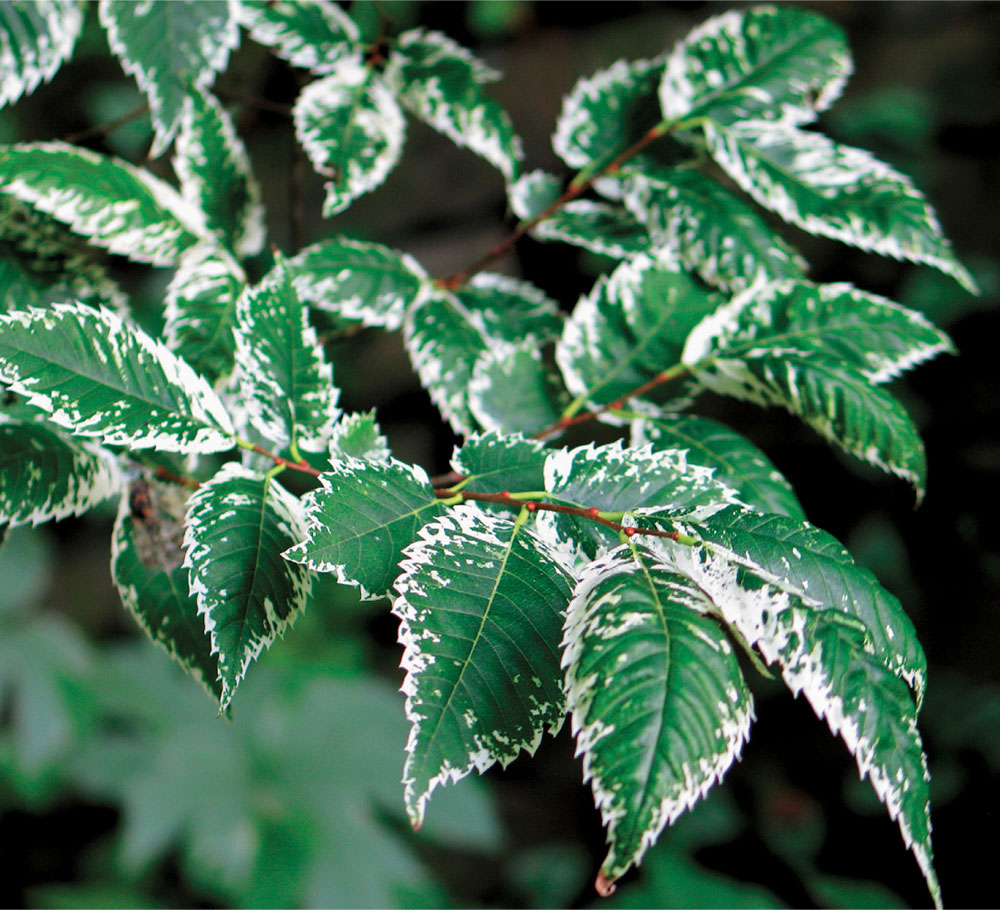
 Zelkova is an adaptable and handsome tree suitable to open yards where it has room to grow, or as a street tree. Fall color can be showy in shades of gold, orange, red, or purple. Zelkova is particularly good in the South, growing well into Zone 8.
Zelkova is an adaptable and handsome tree suitable to open yards where it has room to grow, or as a street tree. Fall color can be showy in shades of gold, orange, red, or purple. Zelkova is particularly good in the South, growing well into Zone 8.  FULL SUN.
FULL SUN.  ZONES 5 TO 8.
ZONES 5 TO 8.
Originally touted as the replacement for the American elm, which was quickly succumbing to Dutch elm disease, Japanese zelkova (Zelkova serrata) is perhaps not as elegant as the American elms of old, but makes a fine substitute both for the Siberian and Chinese elms in gardens where another alternative is needed. Zelkova is a handsome, upright tree in its youth, becoming more vase-shaped as it ages. Fast-growing when young, it may grow as much as 3 feet a year under ideal conditions. ‘Green Vase’ and ‘Village Green’ are both popular varieties, and a form known as ‘Variegata’, available through several collector’s nurseries, has a beautiful white margin on each leaf.

 Lacebark elm is an excellent choice where a tough, durable tree is needed to thrive in a difficult situation. Lacebark elm has smooth, silvery gray bark that flakes and peels to reveal attractive cinnamon and tan new bark underneath.
Lacebark elm is an excellent choice where a tough, durable tree is needed to thrive in a difficult situation. Lacebark elm has smooth, silvery gray bark that flakes and peels to reveal attractive cinnamon and tan new bark underneath.  FULL SUN TO PART SUN.
FULL SUN TO PART SUN.  ZONES 4 TO 9.
ZONES 4 TO 9.
Many horticulture professionals would argue that the lacebark elm (Ulmus parvifolia) is just as weedy and undesirable as its cousin, the Siberian elm. Admittedly, it does seed about with some abandon, especially in the garden, but the seedlings are small and easily removed and you’re usually weeding in the spring anyway. Its propensity to produce viable seed aside, the lacebark elm does have a number of redeeming qualities. It is tough, durable, and will grow on almost any site, in any type of soil. The bark flakes off, sometimes in rather large sections, giving a beautifully patterned and mottled look to the tree trunk and larger limbs. Most important, perhaps, is the fact that it seems nearly impervious to Dutch elm disease. For additional color in the landscape, consider the cultivar ‘Golden Rey’ with golden yellow leaves in spring, summer, and fall.
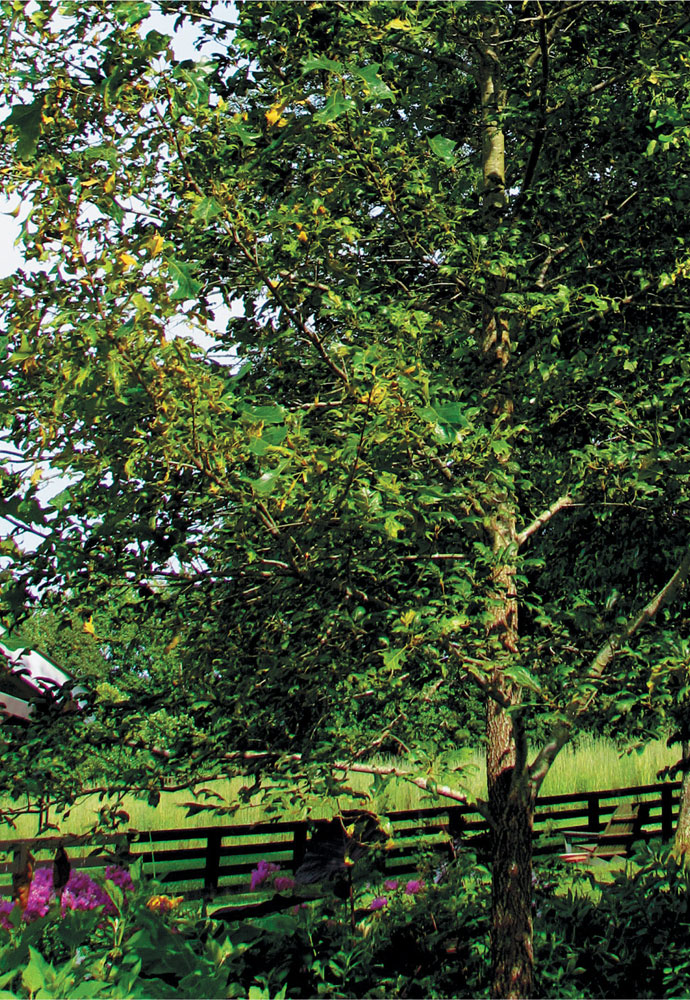
 Red oak is a valuable and fast-growing substitute of similar size to sweetgum. Autumn color is not as showy as sweetgum, but can be a pleasing red in most years. Fast-growing in its youth, red oak makes a nice tree in a few years’ time.
Red oak is a valuable and fast-growing substitute of similar size to sweetgum. Autumn color is not as showy as sweetgum, but can be a pleasing red in most years. Fast-growing in its youth, red oak makes a nice tree in a few years’ time.  FULL SUN.
FULL SUN.  ZONES 4 TO 8.
ZONES 4 TO 8.
If the thought of even a few spiky sweetgum pods gives you cause for concern, but you enjoy the thought of having nice fall color, red oak (Quercus rubrum) also may make a good substitute. While it is not seedless, its acorns are relative small and ultimately less messy than the large, ping-pong-ball-sized seeds of the sweetgum. Nearly identical in size and growth habit, the red oak also bears semiglossy, sharply pointed leaves, and while its fall color may not be as spectacular as the sweetgum, it can be a pleasantly bright shade of red in autumn. It is also one of the faster growing oaks, often averaging 2 feet per year in its youth, making a nice specimen in less than 10 years and an impressive shade tree as it ages.

 Sweetgums are deeply rooted trees whose roots rarely cause problems for building foundations or the buckling of sidewalks and driveways. “Fruitless” forms of sweetgum may still bear some seedpods, but in much less quantity than the standard forms.
Sweetgums are deeply rooted trees whose roots rarely cause problems for building foundations or the buckling of sidewalks and driveways. “Fruitless” forms of sweetgum may still bear some seedpods, but in much less quantity than the standard forms.  FULL SUN.
FULL SUN.  ZONES 5 TO 9.
ZONES 5 TO 9.
Sweetgum is one of the most desirable native trees for its strong, sturdy structure; fast rate of growth; and exceptional fall color in shades of gold, orange, and deep red. In fact, they can be so spectacular in autumn that they almost look as if they’re on fire. Their only drawback, really, is the copious quantity of seedpods they produce and the fact that those seedpods are hard and woody and aren’t going to disappear on their own once they fall to the ground. ‘Rotundiloba’ is a form that is known to produce fewer fruits than most other varieties. Some sources even call it fruitless, which isn’t quite accurate, but close. Its unique leaves have rounded tips instead of the traditional, sharply pointed ones, giving it a slightly different appearance in the landscape.